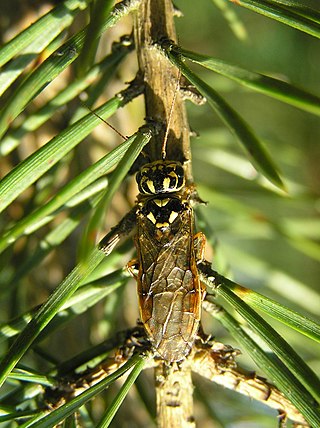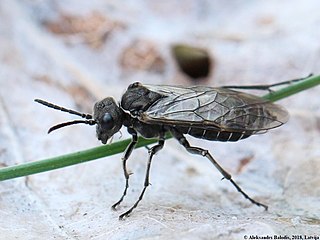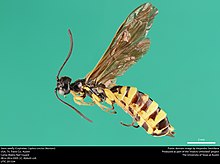
The bean weevils or seed beetles are a subfamily (Bruchinae) of beetles, now placed in the family Chrysomelidae, though they have historically been treated as a separate family. They are granivores, and typically infest various kinds of seeds or beans, living most of their lives inside a single seed. The subfamily includes about 1,650 species and are found worldwide.

Bostrichoidea is a superfamily of beetles. It is the type superfamily of the infraorder Bostrichiformia.

The Melanoplinae are a subfamily of grasshoppers in the family Acrididae. They are distributed across the Holarctic and Neotropical realms. They are one of the two largest subfamilies in the Acrididae. As of 2001 the Melanoplinae contained over 800 species in over 100 genera, with more species being described continuously.

Pamphiliidae is a small family within Symphyta, containing some 200 species from the temperate regions of North America and Eurasia. The larvae feed on plants, using silk to build webs or tents, or to roll leaves into tubes in which they feed, thus earning them the common names leaf-rolling sawflies or web-spinning sawflies. Some species are gregarious and the larvae live in large groups. Fossils of Pamphiliidae have been dated to the Jurassic period.

The Tenthredinoidea are the dominant superfamily of sawflies within the Symphyta, containing some 8,400 species worldwide, primarily in the family Tenthredinidae. All known larvae are phytophagous, and a number are considered pests.

Tenthredinidae is the largest family of sawflies, with well over 7,500 species worldwide, divided into 430 genera. Larvae are herbivores and typically feed on the foliage of trees and shrubs, with occasional exceptions that are leaf miners, stem borers, or gall makers. The larvae of externally feeding species resemble small caterpillars. As with all hymenopterans, common sawflies undergo complete metamorphosis.

Stenobothrus is a genus of grasshoppers found in Asia, Europe, and North Africa.

The minute tree-fungus beetles, family Ciidae, are a sizeable group of beetles which inhabit Polyporales bracket fungi or coarse woody debris. Most numerous in warmer regions, they are nonetheless widespread and a considerable number of species occur as far polewards as Scandinavia for example.

Bembidion is the largest genus of beetles in the family Carabidae by number of species. All species are small and move very fast. Most of them live close to water. The genus has a biantitropical distribution, meaning they are found in both the Northern and Southern Hemispheres, but not in the tropics. In warmer regions it is substituted by closely related Tachys and other genera.

Attagenus is a genus of beetles. This genus is found in tropical Africa, the Palearctic including Europe, the Near East, the Nearctic, North Africa and East Asia. There are nearly 200 species. The genus has existed for at least 99 million years, with fossils known from the Cenomanian aged Burmese amber and Turonian aged New Jersey amber.
Temnaspis is a genus of beetles in the family Megalopodidae, containing the following species:

Cephidae is a family of stem sawflies in the order Hymenoptera. There are about 27 genera and more than 160 described species in Cephidae.

Tenthredopsis is a genus of common sawflies belonging to the family Tenthredinidae subfamily Tenthrediniinae. These sawflies are present in most of Europe.

Podismini is a tribe of "spur-throated grasshoppers" in the family Acrididae. This tribe is unlike others in the subfamily Melanoplinae in that genera are found throughout the northern hemisphere, with a substantial number occurring outside the Americas.

Phylloecus is a genus of sawflies belonging to the family Cephidae.

Sciapteryx is a genus of insects belonging to the family Tenthredinidae.

Micropodisma is a genus of Palaearctic grasshoppers in the tribe Podismini and subtribe Podismina, erected by D.P. Dovnar-Zapolskij in 1932. Species have a recorded distribution from the Balkans, southern Russia to Kazakhstan.
















